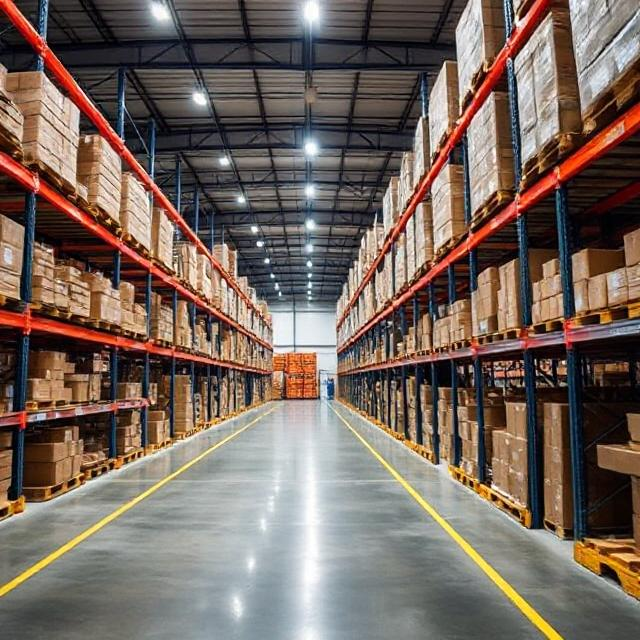Third-party logistics (3PL) warehouse space is crucial in helping businesses manage their storage and distribution needs. In today’s fast-paced world, companies want to focus on growing their core operations, leaving logistics and storage to experts. 3PL warehouses offer the ideal solution by providing professional storage services and helping businesses streamline operations. If you’re a business owner or someone involved in logistics, understanding 3PL warehouse space is key to optimizing your supply chain and improving efficiency.
In this article, we will explore what 3PL warehouse space is, its benefits, how it works, and why it’s an essential part of modern supply chains. Whether you are considering using a 3PL warehouse or looking to expand your current operations, this article will provide all the insights you need.
What is 3PL Warehouse Space?
Definition of 3PL Warehouse Space
Third-party logistics 3PL warehouse space refers to storage facilities provided by logistics companies that specialize in managing warehousing and distribution for other businesses. A 3PL company is a third party between manufacturers, retailers, and customers, offering services such as inventory storage, picking, packing, and shipping.
These warehouses are designed to help businesses store their products and manage logistics without needing to own or maintain their own warehouse space. Companies can scale their operations up or down based on demand, without the overhead costs of owning a warehouse.
Types of 3PL Warehouse Space
There are different types of 3PL warehouse spaces, each designed to meet specific business needs:
- Public Warehouses: These are available for any business to rent. Public 3PL warehouses are typically cost-effective and offer flexible terms, making them ideal for small to medium-sized businesses that don’t require a dedicated space.
- Private Warehouses: Larger companies that need dedicated space often use private 3PL warehouses. These warehouses are customized to the needs of a specific business and are more expensive than public options but offer more control and security.
- Automated Warehouses: These modern warehouses use technology like robots and automated systems to manage inventory. They are especially useful for businesses with high volumes of products and orders.
- Climate-Controlled Warehouses: Certain products, such as food or pharmaceuticals, require specific temperature or humidity conditions. Climate-controlled 3PL warehouses help ensure that goods are stored properly.
Why Do Businesses Need 3PL Warehouse Space?
Focus on Core Competencies
By outsourcing warehousing and logistics to a 3PL provider, businesses can focus on what they do best—whether that’s manufacturing products, improving customer service, or growing their brand. Instead of worrying about inventory management and fulfillment, companies can leave it to the experts.
Cost Savings
Owning and operating a warehouse comes with many expenses, such as rent, utilities, maintenance, and employee salaries. A 3PL provider can reduce these costs by offering flexible pricing based on the amount of space used. Businesses pay only for the storage they need, which helps lower overhead costs.
Scalability and Flexibility
With 3PL warehouse space, businesses have the flexibility to scale their operations. As demand fluctuates, companies can adjust their storage requirements without being locked into long-term commitments. This scalability allows businesses to grow without the worry of overcommitting to a physical space.
Speed and Efficiency
Speed is critical in modern supply chains. With 3PL warehouse space, businesses can benefit from faster order processing and shipping. These warehouses often have advanced technology and efficient processes in place that help minimize delays and streamline fulfillment. For companies importing from overseas, especially from Asia, the mode of transport plays a key role in maintaining delivery speed. In scenarios where time is of the essence, air freight from Japan to UK offers one of the quickest ways to move goods across continents, helping businesses stay agile and responsive. When paired with strategically located 3PL facilities, this creates a powerful logistics setup that supports both rapid distribution and long-term scalability.
How Does 3PL Warehouse Space Work?
The Process of Storing and Shipping Products
Once a business signs a contract with a 3PL provider, the process begins. Here’s a general overview of how 3PL warehouses work:
- Receiving Products: Products are delivered to the 3PL warehouse. They are unloaded, inspected, and stored in designated areas based on size, weight, or type.
- Inventory Management: 3PL providers use software systems to track inventory. This ensures that businesses always know how much stock is available and can make informed decisions about restocking or shipping.
- Order Fulfillment: When a customer places an order, the 3PL warehouse picks the products from storage, packs them securely, and ships them to the customer.
- Shipping and Delivery: 3PL providers often partner with shipping carriers to ensure timely delivery. Many 3PL companies offer a range of shipping options, from standard ground shipping to expedited services.
Technology in 3PL Warehouses
Technology plays a significant role in the efficiency of 3PL warehouse space. Warehouse Management Systems (WMS) are used to track inventory in real time, and many 3PL providers use automation to speed up processes like order picking, packing, and shipping. These systems help improve accuracy, reduce human error, and ensure faster order fulfillment.
Some 3PL companies also offer integrated platforms where businesses can manage their inventory, track orders, and view shipping details all in one place. This connectivity helps improve communication between the 3PL provider and the business, ensuring everything runs smoothly.
Benefits of Using 3PL Warehouse Space
Reduced Capital Investment
One of the main advantages of 3PL warehouse space is that businesses don’t need to invest heavily in infrastructure. With no need to purchase or lease a warehouse, businesses can avoid large capital expenses and redirect those funds into other areas of growth.
Increased Efficiency and Speed
3PL warehouses are equipped with advanced technology and optimized processes to speed up the movement of goods. This means businesses can fulfill orders faster, leading to quicker delivery times and happier customers.
Better Inventory Management
With real-time tracking and automated inventory systems, 3PL providers offer superior inventory management. Businesses can ensure they have the right amount of stock at all times, reducing the risk of stockouts or overstocking.
Improved Customer Satisfaction
With faster shipping times and accurate order fulfillment, 3PL warehouses help businesses keep customers happy. Many 3PL providers also offer customer service support, handling any issues that may arise with shipping or inventory.
How to Choose the Right 3PL Warehouse Space
Assess Your Business Needs
Before selecting a 3PL provider, businesses need to assess their storage and distribution needs. Consider factors such as the volume of products, the type of goods, and the required delivery times. This will help determine which type of warehouse is the best fit.
Consider the Technology and Services Offered
Look for a 3PL provider that uses modern technology to manage inventory and order fulfillment. A good WMS and automated systems can make a significant difference in efficiency. Also, consider the range of services offered, such as returns management or packaging services.
Review Pricing and Terms
Pricing varies depending on factors like warehouse location, storage volume, and services required. It’s important to compare pricing and contract terms from different providers to ensure you’re getting the best value.
Look at Reputation and Customer Service
Choose a 3PL provider with a solid reputation and reliable customer service. Read reviews and ask for referrals to ensure the provider has a history of delivering on their promises.
Conclusion
3PL warehouse space offers a flexible, cost-effective solution for businesses looking to streamline their logistics and focus on their core operations. Whether you’re a small business just starting or a large company looking to scale, partnering with a 3PL provider can save you time, money, and effort.
By outsourcing warehousing and distribution to experts, businesses can reduce capital investment, improve efficiency, and provide faster service to customers. With a wide range of 3PL services available, businesses can find the right solution that fits their unique needs.
FAQs
What is the difference between 3PL and 4PL?
A 3PL (third-party logistics) provider manages the warehousing, storage, and distribution of goods for businesses, while a 4PL (fourth-party logistics) provider takes it a step further by managing the entire supply chain. A 4PL often handles everything from sourcing to logistics strategy, including overseeing the 3PL provider.
How much does 3PL warehouse space cost?
The cost of 3PL warehouse space depends on factors such as the size of the space, the volume of products being stored, the services offered (e.g., packaging or inventory management), and the location of the warehouse. Pricing is usually based on a per-pallet or per-square-foot rate, with additional fees for special services like expedited shipping.
Can a business use 3PL warehouse space for international shipping?
Yes, many 3PL providers offer international shipping services. They can help businesses manage cross-border logistics, including customs clearance and delivery to other countries. Using 3PL providers with a global reach helps businesses expand without managing the complexities of international shipping on their own.
How can 3PL warehouse space help with seasonal demand?
3PL warehouse space offers great flexibility to manage seasonal demand. Businesses can scale their storage needs up or down based on fluctuations in sales, without committing to long-term lease agreements. This flexibility ensures that businesses can meet peak demand without wasting resources during slow seasons.
Do 3PL providers offer returns management?
Yes, many 3PL providers offer returns management services. This involves handling the return of products from customers, inspecting them, and restocking them or processing them for resale. It’s a useful service for businesses that deal with high return rates or want to streamline their return process.





